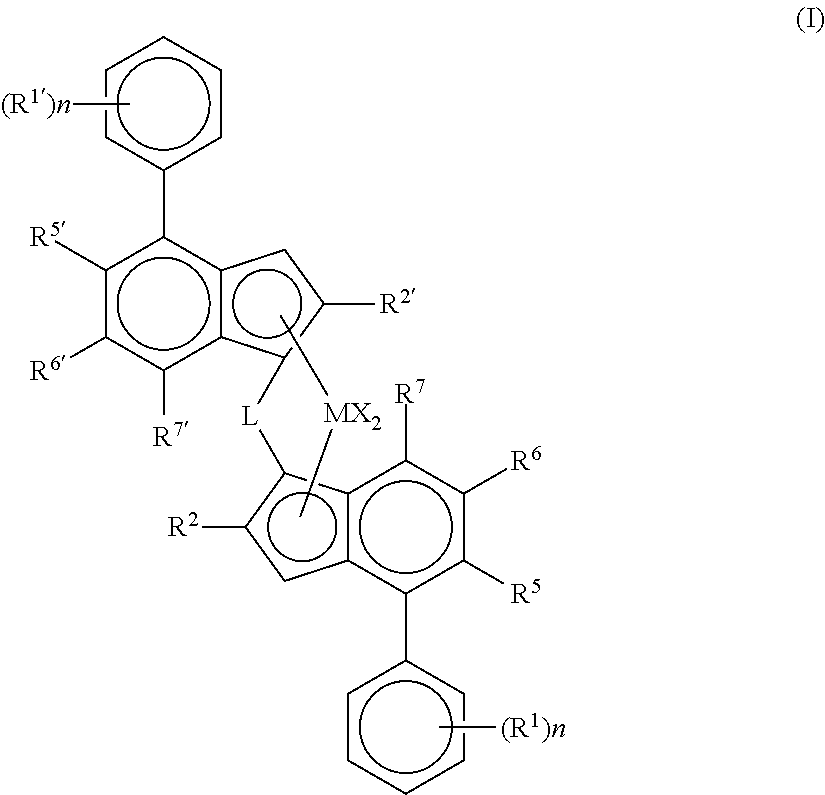Catalyst system for producing polyethylene copolymers in a high temperature solution polymerization process
a polyethylene copolymer and high temperature solution technology, applied in the direction of metallocenes, organic chemistry, chemistry apparatus and processes, etc., can solve the problem that the catalyst that is valuable for slurry and gas-phase processes might be a poor choice for use in a high-temperature solution process, and achieve excellent comonomer incorporation and thermal stability, excellent productivity
- Summary
- Abstract
- Description
- Claims
- Application Information
AI Technical Summary
Benefits of technology
Problems solved by technology
Method used
Image
Examples
##ventive example 1
Inventive Example 1
Rac Complex 1-Zr was Used for Preparing Inventive Catalyst System ICS-1
Step 1.
[0296]Inside the glovebox, 87.90 mg of Rac C1-Zr, prepared as described above was mixed with 4 ml of 30 wt.-% Chemtura MAO in a septum bottle and the solution was stirred for 60 minutes and then 105.2 mg of trityl tetrakis(pentafluorophenyl)borate was added. The mixture was left to react overnight at room temperature inside the glovebox. Then, in another septum bottle, 54 μL of dry and degassed FluorN 474 was mixed with 2 mL of 30 wt.-% Chemtura MAO.
[0297]The solutions were left under stirring overnight.
[0298]The following day, 4 mL of the MAO-metallocene-borate solution and 1 mL of the surfactant-MAO solution were successively added into a 50 mL emulsification glass reactor containing 40 mL of PFC at −10° C. and equipped with an overhead stirrer (stirring speed=600 rpm). Total amount of MAO is 5 mL (200 equivalents). A red emulsion formed immediately (measured emulsion stability=19 seco...
##ventive example 2
Inventive Example 2
Rac Complex 1-Zr was Used for Preparing Inventive Catalyst System ICS-2
[0300]Inside the glovebox, 88.03 mg of complex 1-Zr was mixed with 5 ml MAO in a septum bottle and the solution was stirred for 60 minutes and then 105.15 mg of tritylBF20 was added. The mixture was left to react overnight at room temperature inside the glovebox. (preparation method according to above described step 1, no prepolymerization step)
##ventive example 3
Inventive Example 3
Rac Complex 2-Zr was Used for Preparing Inventive Catalyst System ICS-3
[0301]Inside the glovebox, 111.65 mg of complex 2-Zr was mixed with 5 ml MAO in a septum bottle and the solution was stirred for 60 minutes and then 105.15 mg of tritylBF20 was added. The mixture was left to react overnight at room temperature inside the glovebox. (preparation method according to above described step 1, no prepolymerization step)
PUM
| Property | Measurement | Unit |
|---|---|---|
| temperature | aaaaa | aaaaa |
| pressure | aaaaa | aaaaa |
| density | aaaaa | aaaaa |
Abstract
Description
Claims
Application Information
 Login to View More
Login to View More - R&D
- Intellectual Property
- Life Sciences
- Materials
- Tech Scout
- Unparalleled Data Quality
- Higher Quality Content
- 60% Fewer Hallucinations
Browse by: Latest US Patents, China's latest patents, Technical Efficacy Thesaurus, Application Domain, Technology Topic, Popular Technical Reports.
© 2025 PatSnap. All rights reserved.Legal|Privacy policy|Modern Slavery Act Transparency Statement|Sitemap|About US| Contact US: help@patsnap.com



